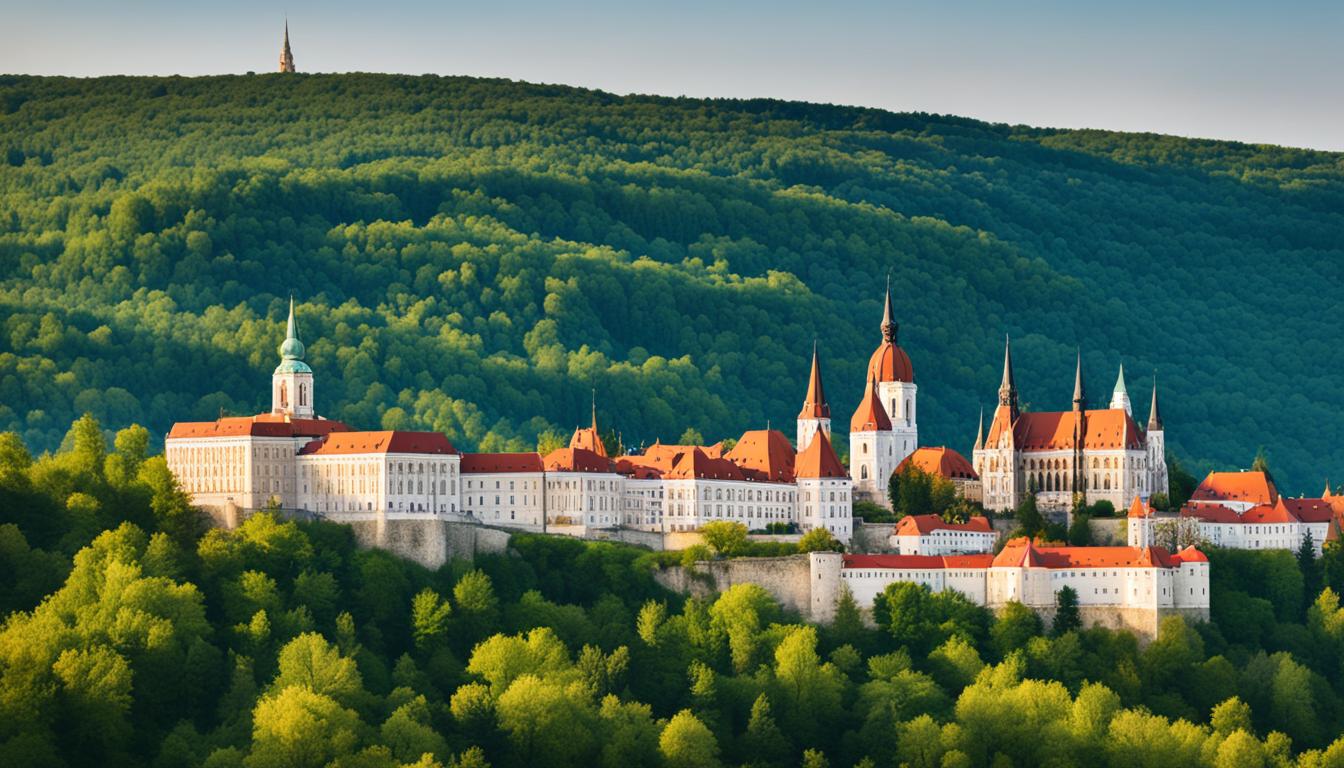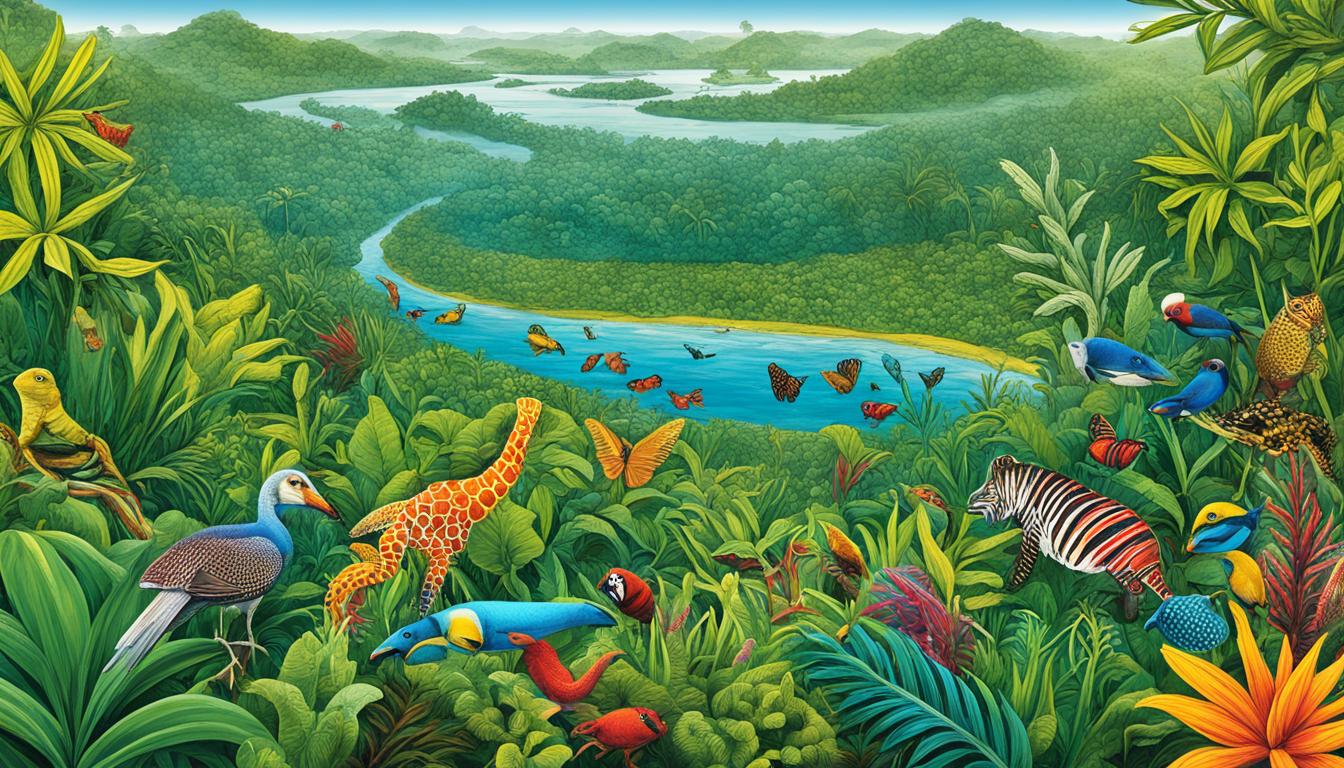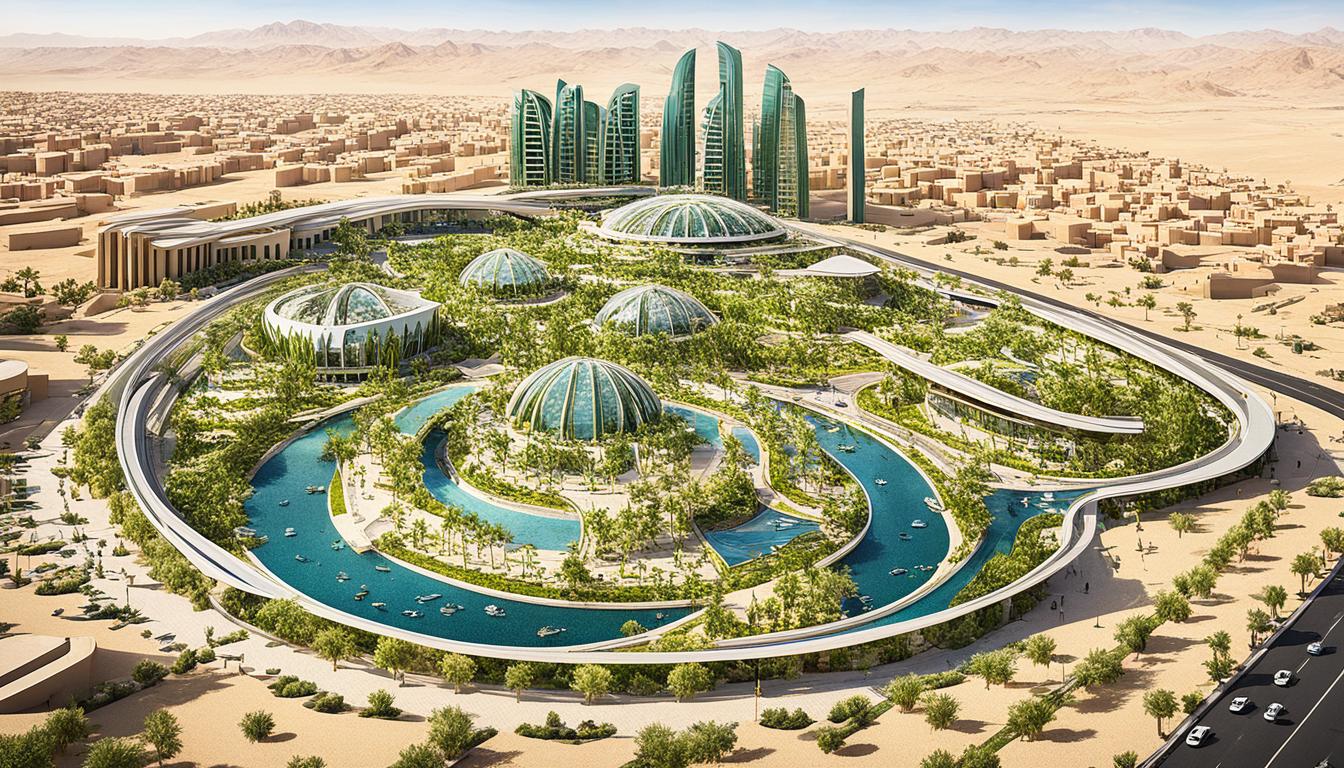Iceland Sacred Natural Sites and Biodiversity
Did you know that Iceland is home to sacred natural sites that are not only culturally significant but also vital for biodiversity conservation? With its unique landscapes and rich ecological diversity, Iceland has implemented measures for nature conservation and the preservation of its biodiversity. The country’s commitment to sustainable tourism and environmental protection plays a crucial role in safeguarding these sacred sites and their associated wildlife habitats.
Key Takeaways
- Iceland is home to sacred natural sites that hold cultural and spiritual significance.
- These sites play a crucial role in biodiversity conservation.
- Iceland’s commitment to sustainable tourism and environmental protection contributes to the preservation of sacred natural sites and their associated wildlife habitats.
- The country’s unique landscapes and rich ecological diversity make it an important area for nature conservation.
- Iceland serves as a model for global efforts in preserving cultural heritage and ecological balance.
The Significance of Sacred Natural Sites
Sacred natural sites hold immense cultural and spiritual value for the people of Iceland. These sites are recognized as protected areas, contributing to the overall ecological richness of the country.
Iceland’s sustainable tourism practices aim to balance the preservation of these sacred sites with responsible visitor management.
The sustainable tourism approach ensures the long-term conservation of Iceland’s natural heritage and enhances the visitor experience.
“The protected areas in Iceland play a vital role in safeguarding the country’s ecological richness. These sites serve as critical habitats for diverse flora and fauna, supporting the overall biodiversity of the region.”
By responsibly managing visitor numbers and promoting sustainable tourism activities, Iceland aims to avoid overexploitation of these natural sites and minimize ecological impact. This approach allows visitors to experience the beauty of these sacred places while simultaneously protecting their fragile ecosystems.
The significance of sacred natural sites extends beyond ecological considerations; they are essential for maintaining the cultural identity of the Icelandic people. These sites are intricately linked to folklore, mythology, and traditional practices, acting as living legacies of Iceland’s rich cultural heritage.
Visitors to sacred natural sites in Iceland are often encouraged to learn about the cultural significance of these places, fostering a deeper appreciation for the country’s diverse traditions and beliefs. By promoting responsible tourism practices, Iceland strives to create a harmonious balance between cultural preservation and environmental protection.
Ecological Richness and Sustainable Tourism
Iceland’s ecological richness is evident in its vast landscapes, diverse ecosystems, and unique flora and fauna. The country’s commitment to sustainable tourism aims to safeguard this ecological wealth and ensure its long-term preservation.
- Protected areas in Iceland encompass various ecosystems, including glaciers, volcanic landscapes, wetlands, and coastal regions.
- These areas provide habitats for a wide range of species, including migratory birds, marine mammals, and endemic flora.
- Strategic management plans and regulations are implemented to protect vulnerable species and maintain the ecological balance.
The sustainable tourism industry in Iceland promotes responsible practices that minimize negative impacts on these fragile environments. This includes guidelines for waste management, sustainable transportation, and the use of eco-friendly accommodations.
Sustainable Visitor Management
To ensure the long-term conservation of sacred natural sites, Iceland has implemented sustainable visitor management strategies.
These strategies include:
- Visitor capacity restrictions to prevent overcrowding and minimize disturbance to sensitive ecosystems.
- Designated trails and viewing platforms to protect fragile habitats and prevent erosion.
- Educational programs and interpretation materials to raise awareness about the importance of ecological preservation.
By striking a balance between the preservation of sacred natural sites and the provision of exceptional visitor experiences, Iceland is setting a benchmark for sustainable tourism practices worldwide.
Biodiversity in Iceland
While Iceland may not have a diverse terrestrial biodiversity compared to other countries, it compensates with its rich marine and aquatic life. The seas surrounding Iceland are teeming with various fish species, and the island serves as an important breeding ground for many bird species in the North Atlantic.
Additionally, Icelandic wildlife habitats support the native Arctic Fox, Icelandic sheep, cattle, chicken, goat, and the iconic Icelandic horse. These wildlife species are adapted to the unique environmental conditions of the country.
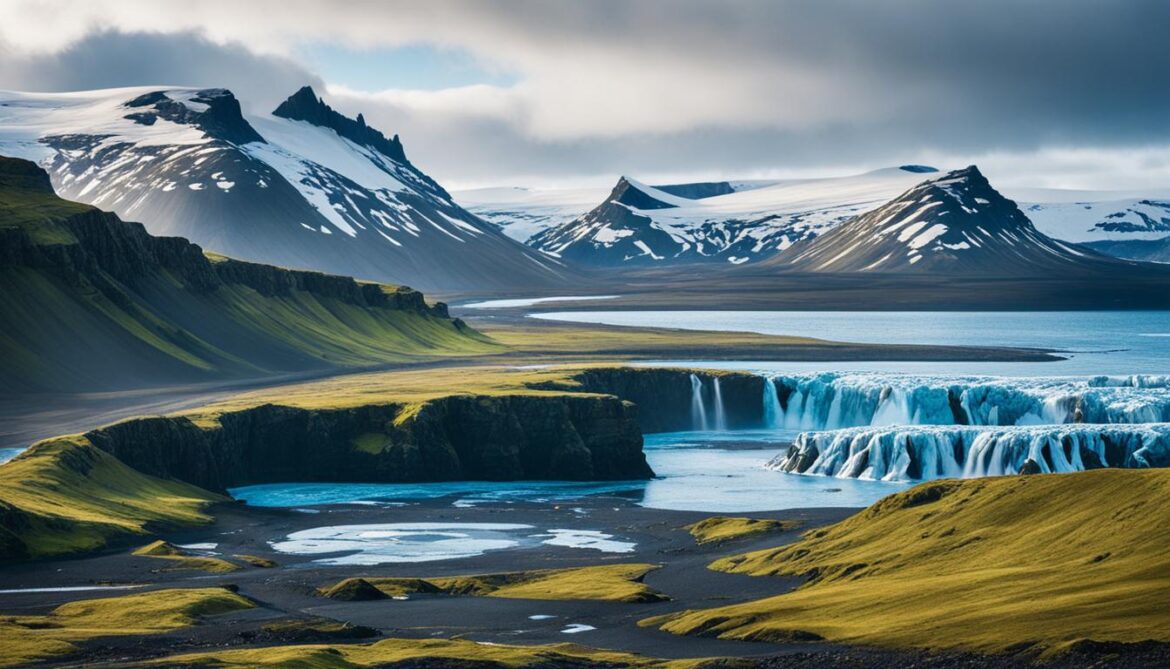
Icelandic wildlife habitats provide a sanctuary for these species to thrive, showcasing the resilience of life in challenging environments. The diverse marine and terrestrial ecosystems in Iceland contribute to the overall ecological balance and offer opportunities for both scientific study and eco-tourism.
With its breathtaking landscapes and abundance of natural wonders, Iceland continues to captivate visitors from around the world. The country’s commitment to preserving its wildlife habitats ensures that future generations can also experience the magic and diversity of Iceland’s unique flora and fauna.
The unparalleled beauty of Iceland’s wildlife habitats and their delicate ecological balance make them worthy of protection and conservation. By safeguarding these habitats, Iceland not only preserves its natural heritage but also contributes to the global efforts in biodiversity conservation.
Importance of Icelandic Marine Ecosystems
| Marine Species | Description |
|---|---|
| Puffin | The Atlantic Puffin is an iconic seabird that breeds in large colonies along Iceland’s cliffs and islands. Its distinct appearance and playful behavior make it a favorite among birdwatchers. |
| Minke Whale | Iceland’s coastal waters are home to the minke whale, a species known for its curious behavior and frequent sightings on whale-watching tours. These majestic creatures play a vital role in maintaining the marine food chain. |
| Salmon | The rivers and streams of Iceland support the annual migration of Atlantic salmon. Anglers from around the world are drawn to Iceland’s pristine waters for the thrill of catching this prized game fish. |
Icelandic Terrestrial Wildlife
- Arctic Fox: The native Arctic Fox is the only native land mammal in Iceland and has adapted to survive in the harsh Arctic climate. Its pure white winter coat is a sight to behold.
- Icelandic Sheep: Icelandic sheep are a hardy breed that roams freely through the countryside, grazing on the natural vegetation. They have been integral to the country’s history and economy for centuries.
- Icelandic Horse: Known for its small stature and sturdy build, the Icelandic horse is a unique breed that has remained unchanged for over a thousand years. These horses are prized for their smooth gaits and gentle temperament.
The symbiotic relationship between Iceland’s wildlife and its stunning landscapes is a testament to the country’s commitment to environmental stewardship and sustainable development. Preserving the Icelandic wildlife habitats is not only a responsibility but also an opportunity to celebrate the wonders of nature.
Indigenous Traditions and Natural Resource Management
Indigenous communities in Iceland have a deep connection to their natural surroundings and play a vital role in environmental protection. The integration of indigenous traditions and environmental protection strategies contributes to the overall preservation of Iceland’s sacred natural sites and biodiversity.
These communities possess traditional ecological knowledge that has been passed down through generations. By combining this knowledge with sustainable practices, they ensure the responsible and sustainable management of natural resources.
Indigenous traditions emphasize the harmonious relationship between humans and nature. This holistic approach to environmental protection recognizes the interconnectedness of all living beings and ecosystems. Through their cultural practices and natural resource management techniques, indigenous communities promote the preservation and conservation of Iceland’s sacred natural sites and the unique biodiversity they support.
Indigenous traditions and environmental protection go hand in hand, creating a harmonious balance between human activities and the natural environment. By respecting and learning from the wisdom of the indigenous communities, we can enhance our efforts in Iceland’s environmental protection and preserve the sacredness of our natural heritage for future generations.
These traditions and practices are not static but continue to evolve and adapt to changing environmental conditions. Indigenous communities collaborate with government agencies, conservation organizations, and local communities to develop sustainable management plans and ensure the long-term preservation of Iceland’s natural resources.
The integration of indigenous traditions into environmental protection strategies fosters a deeper connection between people and nature, reinforcing the importance of responsible stewardship in safeguarding Iceland’s natural heritage.
| Benefits of Indigenous Traditions in Environmental Protection |
|---|
| Promote sustainable natural resource management |
| Enhance biodiversity conservation efforts |
| Cultivate a harmonious relationship between humans and nature |
| Preserve cultural heritage and traditional knowledge |
By recognizing and supporting the pivotal role of indigenous communities, Iceland embraces a holistic approach to environmental protection. The collaboration between different stakeholder groups and the integration of indigenous traditions ensure the sustainable management of natural resources and the long-term preservation of Iceland’s sacred natural sites and diverse ecosystems.
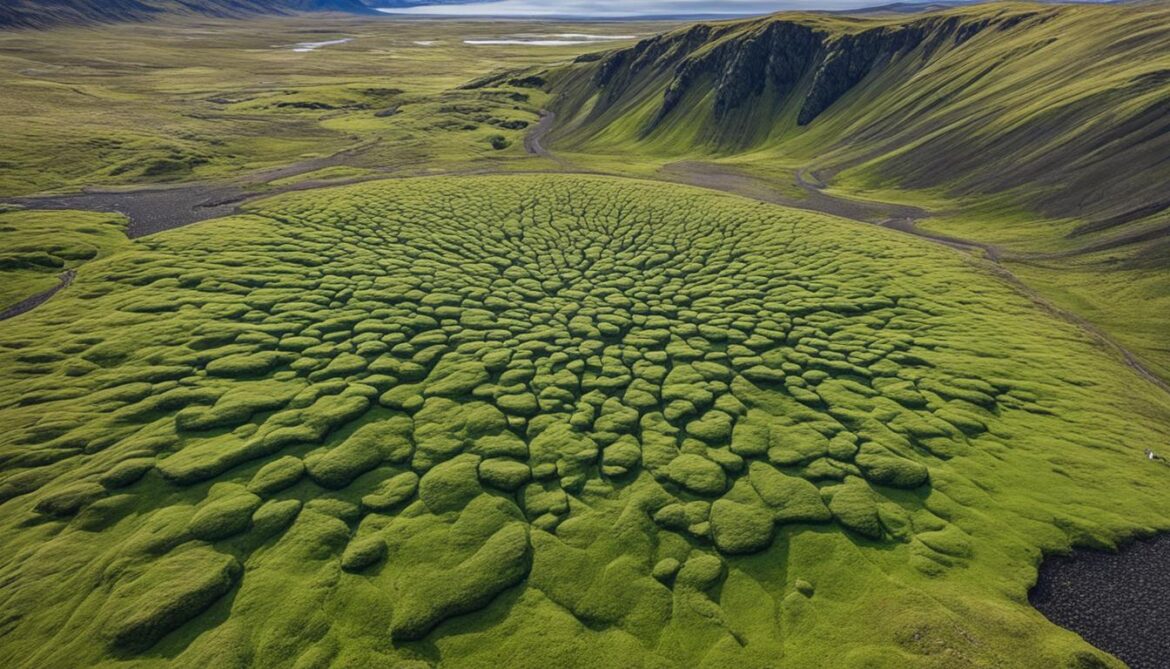
Cultivating a Sustainable Future
Through the integration of indigenous traditions and modern environmental practices, Iceland paves the way for a sustainable future. By valuing and preserving its natural heritage, Iceland sets an example for the rest of the world, showcasing the importance of environmental protection, cultural preservation, and responsible management of natural resources.
Food, Culture, and Religion
Food is an integral part of Icelandic culture and plays a significant role in religious celebrations such as Christmas and Easter. Traditional Icelandic meals showcase a variety of ingredients, reflecting the country’s agricultural heritage and close connection with the surrounding environment. These culinary traditions not only satisfy the taste buds but also align with Iceland’s commitment to environmental protection and sustainable agriculture.
The traditional cuisine of Iceland incorporates a range of locally sourced and seasonal ingredients. Some of the popular food items in Iceland include:
- Lamb: Icelandic lamb is renowned for its tender and flavorful meat. The sheep are allowed to roam freely in the countryside, feeding on wild grasses and herbs, resulting in a unique and distinctive taste.
- Dairy products: Iceland is known for its high-quality dairy products, including skyr (a traditional Icelandic yogurt), cheese, and butter. The dairy industry in Iceland focuses on small-scale production and sustainable farming practices.
- Fish and seafood: With its abundant coastline and rich marine resources, Iceland offers a wide variety of fresh fish and seafood. Popular choices include salmon, cod, haddock, and langoustine.
- Potatoes: Potatoes are a staple in Icelandic cuisine and often accompany main dishes. Icelandic farmers cultivate potatoes using sustainable farming methods, ensuring minimal environmental impact.
- Bread and pastries: Traditional Icelandic bread, such as rúgbrauð (rye bread), is mainly baked using geothermal heat, harnessing the country’s natural resources. Pastries like kleinur (Icelandic twisted doughnuts) are popular treats during festive occasions.
Icelandic culinary traditions prioritize responsible food production and sustainable agriculture. These practices contribute to the country’s environmental protection efforts, ensuring the preservation of Iceland’s pristine landscapes and natural resources.

“The traditional cuisine of Iceland not only satisfies the taste buds but also aligns with Iceland’s commitment to environmental protection and sustainable agriculture.”
Religion in Iceland
In Iceland, Christianity is the dominant religion, with the Evangelical Lutheran Church being the largest denomination. However, surveys indicate a significant decline in religiosity among Icelanders, with a growing number identifying as atheist or not religious. Despite these shifts in religious beliefs, the national church continues to play a role in shaping cultural and social norms.
The spirituality and religious practices in Iceland are diverse and vary among individuals. Some Icelanders find solace and connection through nature, embracing traditional Icelandic beliefs and rituals that align with environmental protection. Others find meaning and purpose in alternative spiritual practices that prioritize personal growth and well-being.
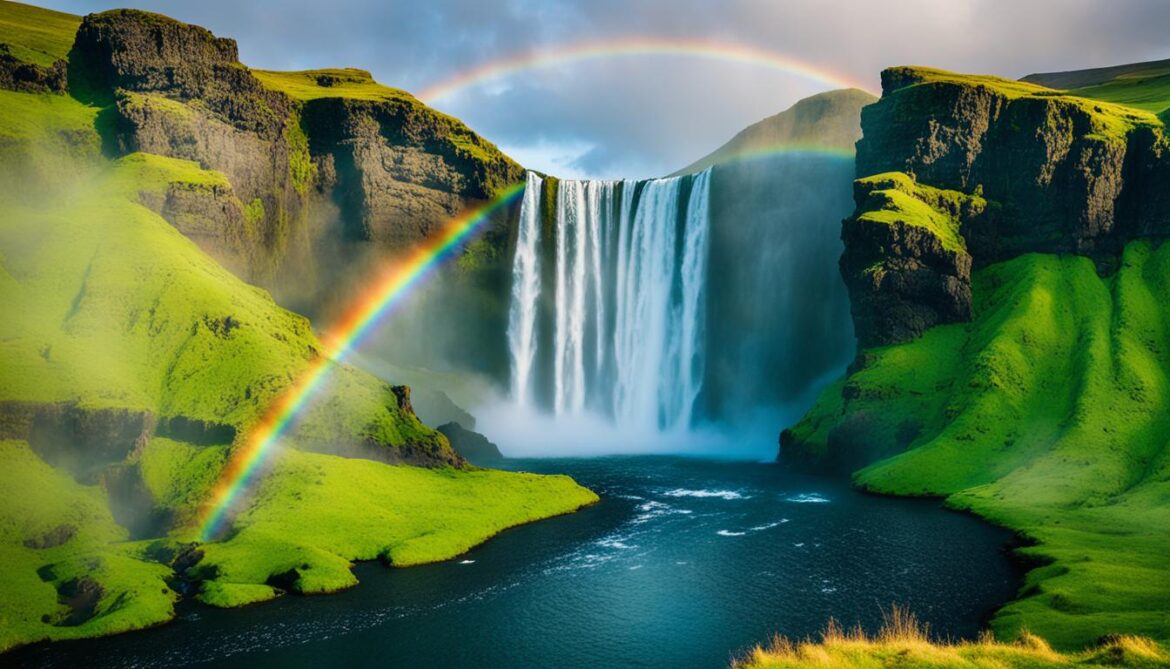
Iceland’s commitment to environmental protection is reflected in the values and principles of its religious and spiritual communities. Many Icelanders view the preservation of the country’s natural beauty and resources as a sacred duty, honoring the interconnectedness of all living beings. As a result, environmental stewardship and sustainability are integral to their religious and spiritual practices.
“Our spiritual connection to the land and the environment is at the heart of our religious beliefs. We are custodians of this beautiful country, and it is our duty to protect and preserve it for future generations.” – Sigrun Arnadottir, Icelandic environmentalist and spiritual practitioner
The Role of Religion in Environmental Activism
Religious and spiritual communities in Iceland actively engage in environmental activism, leveraging their values and convictions to protect the environment. They organize initiatives, educational programs, and campaigns that raise awareness about the importance of Iceland’s environmental protection efforts.
These religious and spiritual communities often collaborate with environmental organizations, governmental agencies, and local communities to advocate for sustainable practices and policies. By integrating their religious beliefs with environmental activism, they aim to inspire positive change and foster a deeper connection between humans and nature.
| Religion in Iceland | Percentage of Population |
|---|---|
| Christianity (including Lutheran, Catholic, and other denominations) | 81.2% |
| Atheist or not religious | 17.9% |
| Other religions (including Buddhism, Islam, and other minority faiths) | 0.9% |
While religious diversity exists in Iceland, the majority of Icelanders still find cultural and spiritual connections through the country’s Christian heritage. However, the evolving religious landscape and the integration of environmental values demonstrate Iceland’s commitment to sustainable development and environmental protection.
Challenges and Conservation Efforts
Despite Iceland’s commitment to environmental protection, there are challenges in ensuring the conservation of sacred natural sites and biodiversity. Human activities, such as tourism, industrial development, and climate change, pose threats to these sites and their associated ecosystems. These challenges require collaborative efforts from various stakeholders to develop effective conservation strategies and promote sustainable practices.
Threats to Sacred Natural Sites and Biodiversity
Tourism, one of Iceland’s main economic sectors, can have adverse effects on the environment. The increase in visitor numbers puts pressure on delicate ecosystems, leading to habitat disturbance and loss. Industrial development, including infrastructure projects and resource extraction, also impacts sacred natural sites and wildlife habitats. Additionally, the effects of climate change, such as rising temperatures, melting glaciers, and changing precipitation patterns, pose significant challenges to the delicate balance of Iceland’s ecosystems.
Despite these challenges, Iceland is taking proactive measures to protect its natural heritage. The conservation efforts involve the collaboration of government agencies, local communities, and indigenous groups.
Collaborative Conservation Approaches
The conservation of sacred natural sites and biodiversity in Iceland necessitates the cooperation of multiple stakeholders. Government agencies play a vital role in establishing protected areas, implementing regulations, and monitoring compliance. Local communities actively participate in conservation initiatives, contributing their traditional knowledge and practices for sustainable resource management. Indigenous groups, with their deep connection to the land, provide valuable insights into environmental protection strategies.
- The government agencies work towards establishing effective management strategies to mitigate the negative impacts of human activities. They enforce regulations that aim to preserve sensitive environments and protect rare and endangered species.
- Local communities actively participate in conservation initiatives and sustainable tourism practices. They engage in activities such as nature-based tourism, eco-friendly farming, and community-led projects.
- Indigenous groups, with their traditional ecological knowledge, contribute to conservation efforts in Iceland. They provide insights into sustainable resource management practices and help raise awareness about the importance of biodiversity preservation.
Promoting Sustainable Practices
Iceland’s commitment to environmental protection extends to promoting sustainable practices across various sectors. The tourism industry, for example, encourages responsible travel through the promotion of eco-friendly accommodations, low-impact outdoor activities, and respect for cultural and natural heritage. The government implements policies that support sustainable agriculture, fisheries, and renewable energy production.
The efforts to combat the challenges and protect Iceland’s natural treasures require ongoing commitment and the integration of sustainable practices into all aspects of society – from government policies to individual choices.
By working together, Iceland can overcome these challenges and ensure the long-term conservation of its sacred natural sites and biodiversity. Through continued collaboration, sustainable resource management, and awareness-raising efforts, Iceland can serve as a model for environmental protection and inspire global conservation initiatives.
Governance and Management of Protected Areas
The governance and management of protected areas in Iceland require a collaborative approach. Guidelines and principles for protected area management provide a framework for effective conservation strategies. Coordination between various stakeholders, including government authorities, indigenous communities, and scientific experts, ensures the sustainable management of protected areas and the preservation of biodiversity.
Iceland’s commitment to nature conservation is reflected in its proactive measures to protect and manage its unique natural landscapes. The establishment of protected areas aims to safeguard vulnerable ecosystems, maintain ecological balance, and preserve the country’s diverse flora and fauna.
Government authorities play a crucial role in overseeing the governance and management of these protected areas. They develop policies, regulations, and management plans that outline the goals and strategies for conservation. By enacting legislation to protect these areas, Iceland demonstrates its dedication to nature preservation and environmental sustainability.
Indigenous communities, such as the Sami people, have been actively involved in the governance and management of protected areas. Their traditional knowledge and close connection to the land contribute to the holistic understanding of these ecosystems and help shape conservation strategies that align with cultural values.
“Conservation should not be an isolated effort; instead, it requires collaboration and cooperation between diverse stakeholders,” says Dr. Anna Jónsdóttir, a renowned environmental scientist. “The involvement of local communities, government agencies, and scientific experts ensures the integration of multiple perspectives and expertise, which is vital for effective management of protected areas.”
Scientific research and monitoring are integral components of the management process. By conducting studies on biodiversity, species distribution, and ecological processes, scientists provide valuable insights into the functioning of these protected areas. This knowledge informs management decisions, facilitates evidence-based conservation efforts, and promotes adaptive management strategies to address emerging challenges.
The sustainable management of protected areas in Iceland also involves the engagement of local communities and visitors. Public awareness campaigns, educational programs, and responsible tourism practices promote conservation ethics and encourage active participation in nature conservation.
Through collaborative governance and management, Iceland strives to balance the preservation of its protected areas with the sustainable use of natural resources. By implementing effective strategies for protection and management, Iceland ensures the long-term preservation of its unique landscapes, diverse ecosystems, and the ecological heritage for future generations.
| Benefits of Collaborative Governance and Management of Protected Areas in Iceland | Examples of Stakeholders |
|---|---|
| Enhanced ecological conservation and biodiversity preservation | Government authorities |
| Promotion of sustainable land and resource management practices | Indigenous communities |
| Integration of traditional knowledge and cultural values in conservation strategies | Scientific experts |
| Effective monitoring and adaptive management based on scientific research | Local communities |
| Increased public awareness and responsible tourism practices | Visitors |
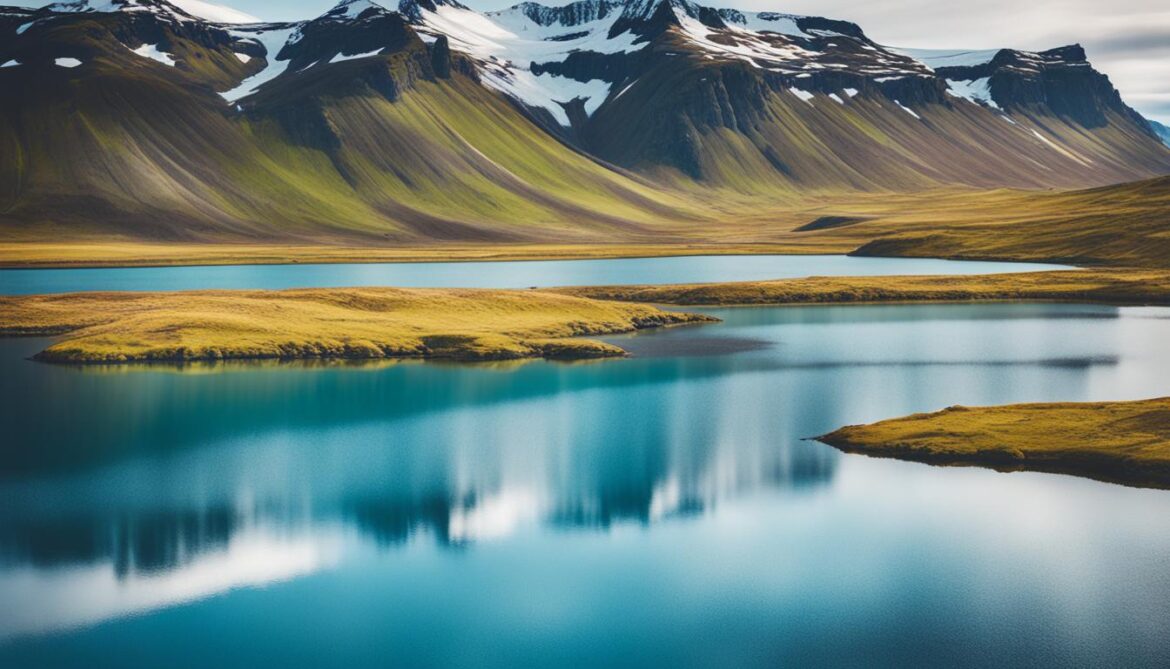
The Role of Indigenous Communities
Indigenous communities in Iceland, such as the Sami people, have a deep connection to the land and play a crucial role in the governance and management of protected areas. Drawing on their traditional ecological knowledge and cultural practices, these communities offer invaluable insights into the sustainable use of natural resources and the conservation of biodiversity.
For centuries, the Sami people have maintained a harmonious relationship with the land, respecting its inherent value and recognizing the interdependence between humans and nature. Their traditional knowledge on reindeer herding and land management contributes to the overall preservation of Iceland’s protected areas and promotes sustainable practices.
The involvement of indigenous communities in decision-making processes ensures the integration of local perspectives, cultural values, and traditional ecological knowledge. This collaboration fosters a deeper understanding of the interconnectedness between nature and culture, leading to more effective management strategies that balance conservation objectives and local needs.
Cultural Heritage and Living Traditions
Cultural heritage and living traditions play a vital role in Iceland’s commitment to the preservation of its sacred natural sites and biodiversity. These sites serve as more than just physical landmarks; they are repositories of knowledge, wisdom, and cultural memory. By protecting and maintaining these cultural heritage sites and living traditions, Iceland ensures the holistic conservation of its sacred natural sites and the unique ecological diversity that they encompass.
Throughout the centuries, Icelanders have passed down traditional practices, language, and customs from one generation to the next. These living traditions are deeply interwoven with the country’s sacred natural sites, reinforcing the bond between the cultural and natural worlds. From ancient folklore to traditional music, dance, and storytelling, these living traditions celebrate Iceland’s rich history and connection to its natural surroundings.
“Iceland’s cultural heritage is a testament to the enduring spirit of its people and their reverence for the land,” says Dr. Anna Jónsdóttir, a renowned cultural anthropologist. “The preservation of our cultural heritage goes hand in hand with the conservation of our sacred natural sites and the biodiversity they support. It is through these sacred sites and living traditions that the essence of Iceland’s identity and ancestral wisdom is kept alive.”
By honoring and protecting cultural heritage and living traditions, Iceland fosters a sense of belonging, pride, and responsibility among its people. These traditions serve as a reminder of the interconnectedness between humans and nature, reinforcing the importance of sustainable living and environmental stewardship.
“Our cultural heritage is not static; it evolves and adapts to changing times while remaining rooted in our past,” adds Dr. Jónsdóttir. “Through ongoing dialogue and engagement, Icelanders continue to reclaim and revitalize ancient practices, ensuring their relevance in the modern world while maintaining a deep connection to our sacred natural sites and the biodiversity they sustain.”
Iceland’s commitment to cultural heritage and living traditions is reflected in its policies and initiatives. The government actively supports cultural heritage preservation through funding, educational programs, and partnerships with local communities. These efforts aim to safeguard the traditional knowledge, skills, and rituals that are intrinsic to Iceland’s cultural identity.

| Benefits of Cultural Heritage and Living Traditions for Conservation | Examples |
|---|---|
| Enhances public awareness and engagement in conservation efforts | The annual celebration of the Winter Lights Festival in Reykjavik showcases traditional music, dance performances, and storytelling sessions, fostering community involvement in cultural and environmental preservation. |
| Strengthens the sense of place and connection to the land | The traditional practice of Ásatrú, the belief system rooted in Norse mythology, emphasizes the interconnectedness between humans and the natural world, promoting a deep respect for Iceland’s sacred sites. |
| Promotes sustainable practices and environmental stewardship | The ancient tradition of rímur singing highlights the importance of harmony with nature, often conveying messages of conservation and respect for the natural environment. |
| Preserves traditional ecological knowledge | Local communities continue to pass down traditional fishing techniques and knowledge of sustainable harvesting practices, contributing to the conservation of marine biodiversity. |
| Fosters pride in cultural heritage and national identity | Icelandic language classes are widely available, encouraging Icelanders to embrace their linguistic heritage and preserve the unique cultural identity associated with the language. |
By recognizing the inseparable relationship between cultural heritage, living traditions, and the conservation of sacred natural sites and biodiversity, Iceland ensures the preservation of its natural and cultural heritage for future generations. Through the collective efforts of individuals, communities, and organizations, Iceland’s cultural legacy continues to thrive, enriching the country’s sustainable future.
The Future of Iceland’s Sacred Natural Sites and Biodiversity
The future of Iceland’s Sacred Natural Sites and Biodiversity depends on the ongoing efforts in nature conservation, sustainable tourism, and environmental protection. To ensure the long-term preservation of Iceland’s natural heritage, it is crucial to strengthen collaborations between different stakeholders and raise awareness about the importance of biodiversity. By integrating traditional knowledge and practices, Iceland can strive towards a sustainable future that upholds both cultural heritage and ecological diversity.
One key aspect of preserving Iceland’s Sacred Natural Sites and Biodiversity is the commitment to nature conservation. Through the establishment of protected areas, the unique landscapes and diverse ecosystems can be safeguarded from detrimental human activities. It is essential to continue implementing sustainable tourism practices that balance visitor enjoyment with the preservation of these sacred sites and their associated wildlife habitats. By doing so, Iceland can ensure that future generations can experience and appreciate the country’s natural wonders.
Raising awareness about the importance of biodiversity is another crucial step towards securing the future of Iceland’s Sacred Natural Sites and Biodiversity. Education and outreach programs can inform locals and visitors alike about the value of protecting and conserving the country’s unique flora and fauna. By fostering a sense of responsibility towards the environment, individuals can actively contribute to biodiversity preservation through their actions and choices.
Integrating traditional knowledge and practices into conservation efforts is vital for the future of Iceland’s Sacred Natural Sites and Biodiversity. Indigenous communities have a deep connection to the land and possess invaluable knowledge about sustainable resource management. By involving these communities and incorporating their wisdom, Iceland can benefit from their traditional ecological knowledge and ensure the long-term preservation of sacred sites and the ecosystems they support.
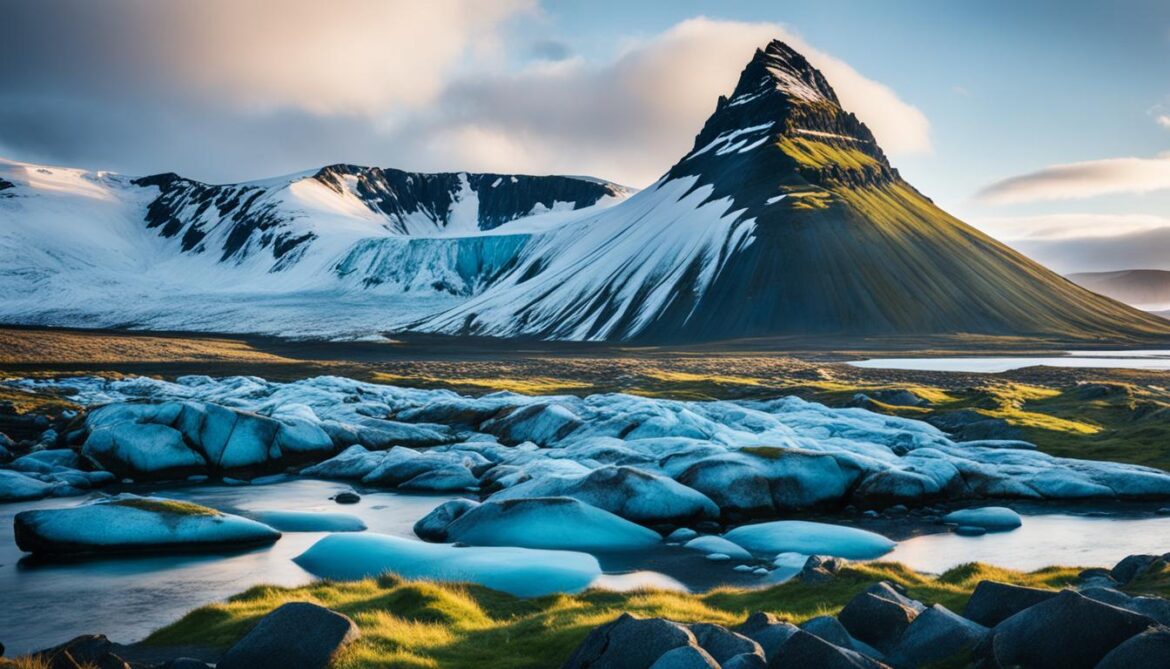
“The future of Iceland’s Sacred Natural Sites and Biodiversity hinges upon our collective commitment to nature conservation, sustainable tourism, and environmental protection. By working together, raising awareness, and valuing traditional knowledge, we can secure a sustainable future that respects our cultural heritage and preserves our unique ecological diversity.”
The preservation of Iceland’s Sacred Natural Sites and Biodiversity requires dedication, cooperation, and the integration of traditional and modern conservation practices. By protecting these sacred sites and their associated ecosystems, Iceland ensures a sustainable future that balances the needs of the present with the preservation of natural wonders for generations to come.
Conclusion
The mystical allure of Iceland’s sacred natural sites and biodiversity captures the essence of ancient reverence and ecological richness. The country’s commitment to sustainable tourism, environmental protection, and indigenous engagement sets a precedent for global conservation efforts. By preserving and conserving Iceland’s sacred natural sites and biodiversity, the country not only safeguards its cultural identity but also maintains the fragile environmental balance that sustains future generations.
Iceland’s sacred natural sites and protected areas are not only a testament to the country’s deep connection to nature but also serve as crucial habitats for a diverse range of species. The conservation and preservation of these areas are vital for maintaining the delicate ecological equilibrium and sustaining Icelandic biodiversity. As Iceland continues to prioritize the preservation of its sacred natural sites and the protection of its biodiversity, it paves the way for other nations to follow suit in creating a sustainable future for our planet.
By implementing effective strategies and management practices, Iceland ensures that its sacred natural sites and protected areas thrive for generations to come. The collaboration between government agencies, local communities, and indigenous groups strengthens the collective effort to preserve Iceland’s natural heritage. Through this collaborative approach and the integration of traditional knowledge and practices, Iceland remains at the forefront of global biodiversity preservation and environmental protection.




